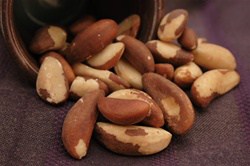The pomelo is a citrus fruit native to Southeast Asia. It is usually pale green to yellow when ripe, with sweet white (or, more rarely, pink or red) flesh and very thick pudgy rind. It is the largest citrus fruit, 15–25 cm in diameter, and usually weighing 1–2 kg. Other spellings for pomelo include pummelo, and pommelo, and other names include Chinese grapefruit, jabong, lusho fruit,pompelmousand shaddock.
The pummelo (Citrus maxima) — known also as the pomelo, the shaddock, the French chadec,the Malayan limau besar, the Bali lemon, and the Chinese grapefruit — has the distinction of being the largest citrus fruit. The pummelo (pronounced pom-EH-loh) is, essentially, a kindler, gentler, giant cousin of the grapefruit. It is similar in flavor but milder, and is actually believed to be a forebear of the modern grapefruit.
The pummelo is native to Malaysia and Southeast Asia. Seeds of the pummelo were introduced to the West Indies by the seafaring English Captain Shaddock, who lent his name to the fruit. Today, pummelos are cultivated in Malaysia still, as well as China, Thailand, Taiwan, Japan, India, Indonesia, Israel, California, and Florida.
Health Benefits of Pummelo
- The rind of pomelo contains a high amount of bioflavonoid. The bioflavonoid in pomelo was discovered to even stop cancer cells from spreading in breast cancer patients by ridding the body of excess estrogen.
- Even if the juice of pomelo has an acid taste, its juice actually has an alkaline reaction after digestion. It is therefore beneficial in the digestive system.
- Pomelo has pectin which is effective in reducing the accumulation of arterial deposits.
- The high content of vitamin C helps to strengthen and maintain the elasticity of arteries.
- Pomelo can aid in the weight loss process, because the fat burning enzyme in pomelo can help to absorb and reduce the starch and sugar in the body.
- Pomelo can even help in cases of fatigue, diabetes, fever, insomnia, sore throat, stomach and pancreatic cancer

